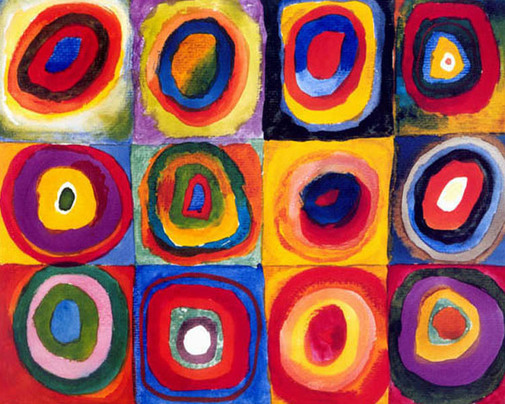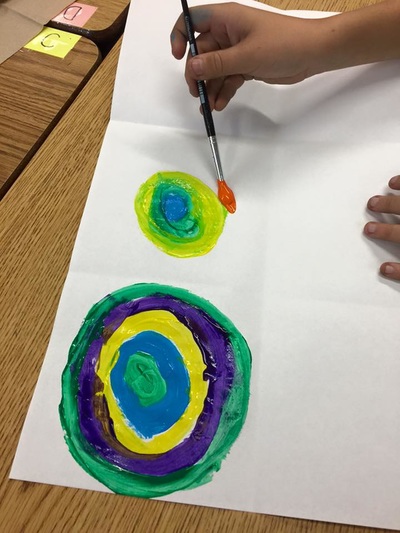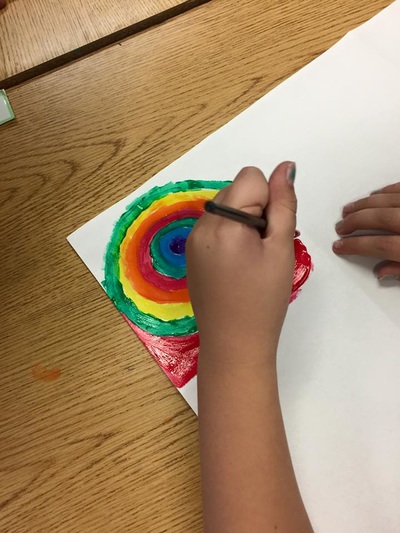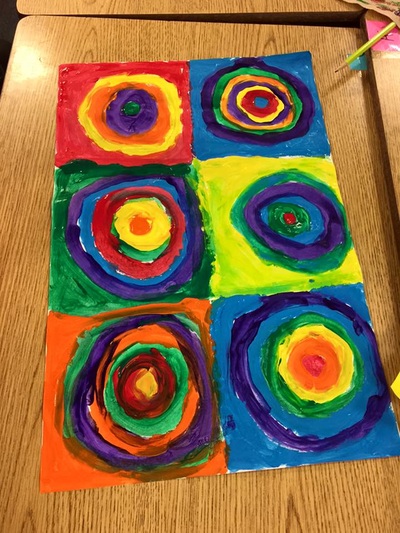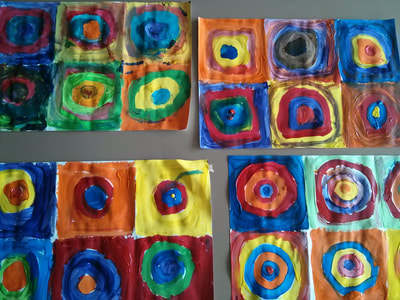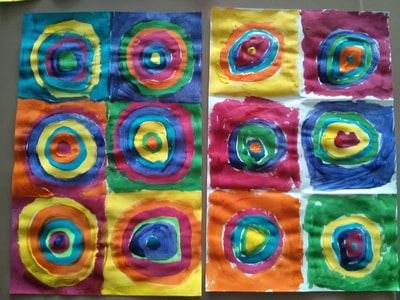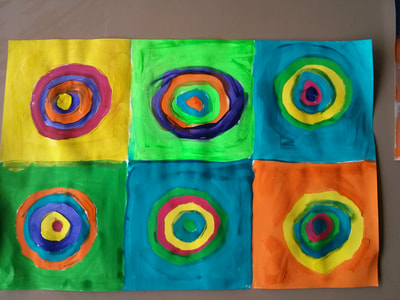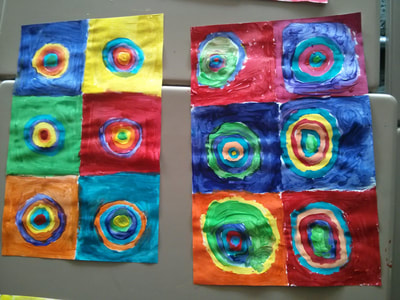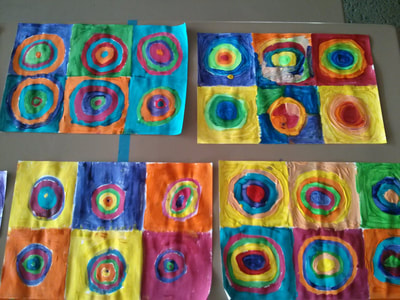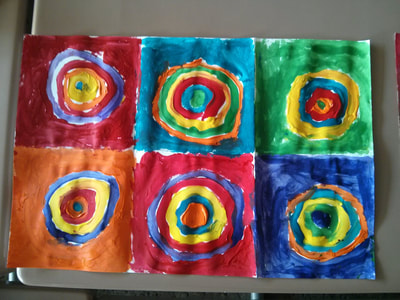Fifth Grade
Kandinsky "Squares with Concentric Circles"
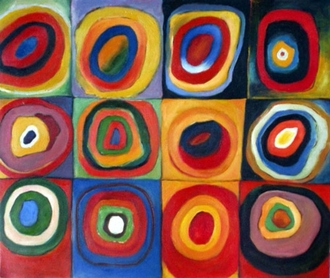
Wassily Kandinsky (1866 - 1944) was a Russian born artist who made his name working in Germany in an art style called Expressionism. Expressionists wanted to use art to express their feelings and emotions, usually through bold us of line and color.
Kandinsky studied law and economics in school, and was very successful in his career, but he also loved art, and eventually decided to do art full time, even becoming an art teacher. As a child he was also interested in music, learning to play both the piano and the cello, and this was an interest that inspired a lot of his art. In fact, many of his paintings were titled as if they were songs or musical works, like "Composition" and "Improvisation."
Kandinsky studied law and economics in school, and was very successful in his career, but he also loved art, and eventually decided to do art full time, even becoming an art teacher. As a child he was also interested in music, learning to play both the piano and the cello, and this was an interest that inspired a lot of his art. In fact, many of his paintings were titled as if they were songs or musical works, like "Composition" and "Improvisation."
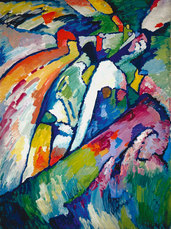
The other thing that Kandinsky was inspired by was COLOR. He felt that color could convey emotion even without showing any particular object or figure. Color on its own could tell the story of his art. Kandinsky was one of the first artists who painted purely ABSTRACT works of art, meaning he abandoned any reference to recognizable reality in his work. He thought of doing this one day by accident: he went into his art studio as the sun was going down and noticed a painting on the easel. He said it was so lovely that he could not stop staring at it, even though as he looked at it he couldn't tell what the subject was, but only noticed the color patches. Finally he got closer to the painting and realized that it was his own painting standing on its side! This is when he decided that he no longer had to have subjects in his paintings, and that he could rely on line and color.
Kandinsky made many paintings that explored the various emotional and expressionistic uses of color. He would often combine different shapes with different colors to see which felt most "right," and he would paint certain colors next to each other to see how they would play off against each other. "Square with Concentric Circles" is one of those color studies. He made several versions of this, always using loose brushwork and very bright, saturated colors. Notice how the color red, for instance, looks different when it is next to colors like yellow and orange (colors next to red on the color wheel) than when the same red is next to green or blue (colors opposite to red on the color wheel). Have the students keep this in mind when choosing colors for their own painting.
Kandinsky made many paintings that explored the various emotional and expressionistic uses of color. He would often combine different shapes with different colors to see which felt most "right," and he would paint certain colors next to each other to see how they would play off against each other. "Square with Concentric Circles" is one of those color studies. He made several versions of this, always using loose brushwork and very bright, saturated colors. Notice how the color red, for instance, looks different when it is next to colors like yellow and orange (colors next to red on the color wheel) than when the same red is next to green or blue (colors opposite to red on the color wheel). Have the students keep this in mind when choosing colors for their own painting.
| kandinsky.pdf | |
| File Size: | 890 kb |
| File Type: | |
The Project
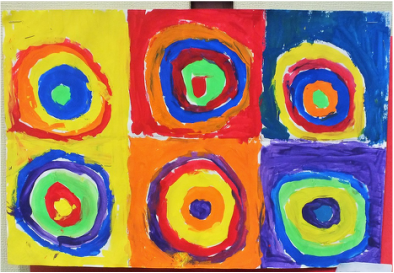
Prep – 1 hour (includes making a sample)
Print -Kandinsky, Squares with Concentric Circles
Materials
- 12 x 12" (or 11 x 11") white construction paper per student (have extra pieces)
Note: pictures show 12x18 paper with 6 sections, but the directions have been revised to make the project fit the time constraints better.
- Tempera paint in primary and secondary colors
- Paint palettes
- Paint brushes, medium sized
- Water containers
Lesson
1. Show students print. Talk about what they see in the print. Shapes, changing colors, etc. Talk about the artist and information provided above.
You might want to bring in a copy of the color wheel as well, and discuss color relationships (see color wheel project from first grade for more info).
2. Vocabulary: Concentric Circles – circles that are on top of each other, changing in size as you draw another but always having the same center axis.
3. Show students your sample and explain what you did to create it. Fold paper in half top to bottom, unfold, then fold side to side, and unfold again to create four sections. Circles could be lightly drawn in with pencil, or merely free-painted as you go.
-each circle should have at least 3 lines around the main center dot, but could have more.
-paint each circle and background a different color.
-the same colors should not touch.
-try to stay inside the lines
Print -Kandinsky, Squares with Concentric Circles
Materials
- 12 x 12" (or 11 x 11") white construction paper per student (have extra pieces)
Note: pictures show 12x18 paper with 6 sections, but the directions have been revised to make the project fit the time constraints better.
- Tempera paint in primary and secondary colors
- Paint palettes
- Paint brushes, medium sized
- Water containers
Lesson
1. Show students print. Talk about what they see in the print. Shapes, changing colors, etc. Talk about the artist and information provided above.
You might want to bring in a copy of the color wheel as well, and discuss color relationships (see color wheel project from first grade for more info).
2. Vocabulary: Concentric Circles – circles that are on top of each other, changing in size as you draw another but always having the same center axis.
3. Show students your sample and explain what you did to create it. Fold paper in half top to bottom, unfold, then fold side to side, and unfold again to create four sections. Circles could be lightly drawn in with pencil, or merely free-painted as you go.
-each circle should have at least 3 lines around the main center dot, but could have more.
-paint each circle and background a different color.
-the same colors should not touch.
-try to stay inside the lines
Art Project
-pass out paper and have students put their names on the back
-have students fold paper in half both ways to create four equal square sections
-have students draw their circles in each square, or, alternatively, you could just have the students paint the circles as they go without pre-drawing them
-have parent volunteers pass out paint palettes filled with 6 different colors of paint, paint brushes, and water containers
NOTE: it works well to have six paint brushes at each palette (one per color) instead of giving the brushes to the students so that the brushes will not need to be rinsed out between every circle
-remind students to paint inside lines and make sure the same colors are not touching
-when students are done you can have parent helpers collect tempera paint, brushes, and water containers
-have a parent helper or students wash out brushes and palettes and take back to art room to WASH AGAIN and leave to dry, flat on the counter
-pass out paper and have students put their names on the back
-have students fold paper in half both ways to create four equal square sections
-have students draw their circles in each square, or, alternatively, you could just have the students paint the circles as they go without pre-drawing them
-have parent volunteers pass out paint palettes filled with 6 different colors of paint, paint brushes, and water containers
NOTE: it works well to have six paint brushes at each palette (one per color) instead of giving the brushes to the students so that the brushes will not need to be rinsed out between every circle
-remind students to paint inside lines and make sure the same colors are not touching
-when students are done you can have parent helpers collect tempera paint, brushes, and water containers
-have a parent helper or students wash out brushes and palettes and take back to art room to WASH AGAIN and leave to dry, flat on the counter
